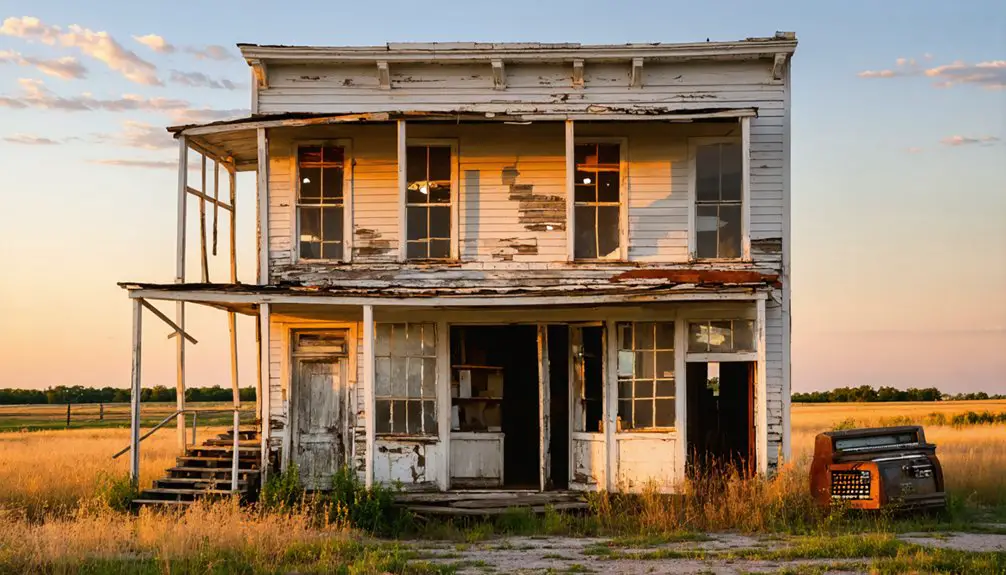You’ll find Lenna’s ghost town remnants in McIntosh County, Oklahoma, where Creek Nation settler Tom Moore established a post office in 1902, naming it after his daughter. The community thrived with 400 residents by 1900, but when rail lines bypassed the area, its decline began. Today, you can explore abandoned structures, broken sidewalks, and a century-old schoolhouse that tell the story of this once-bustling Creek settlement’s transformation into scattered ruins and memories.
Key Takeaways
- Lenna, Oklahoma, once a thriving community of 400 residents in 1900, declined after being bypassed by rail lines and lost its population.
- The town’s post office, established in 1902 by Tom Moore and named after his daughter, operated until 1955 before closing.
- Only scattered residents and abandoned structures remain today, including deteriorating buildings, storefronts, and a century-old schoolhouse.
- The landscape features broken sidewalks, defunct utility poles, old road sections, and collapsed barns from its farming heritage.
- Two churches and a historic cemetery survive as remnants of Lenna’s Creek Indian heritage and early 1900s community life.
Origins of a Creek Nation Settlement
When the Muscogee (Creek) people faced forced relocation from their ancestral lands in Alabama and Georgia during the 1830s, they established new settlements across Indian Territory, including what would become Lenna.
Following the Trail of Tears migration of 1836-1837, you’ll find that Creek Nation settlement patterns emerged along Oklahoma’s river valleys, particularly near the Arkansas, North Fork, Deep Fork, and Canadian rivers.
Creek settlements flourished along Oklahoma’s major waterways after the Trail of Tears, establishing new roots in their forced homeland.
The nation’s political structure adapted, uniting Upper and Lower Creek towns under a centralized government by 1840. While the capital was initially at Council Hill near present-day Tulsa, it later moved to Okmulgee.
Lenna developed as part of this network of Creek communities, blending traditional town organization with new administrative systems that helped preserve cultural continuity despite displacement. Each settlement maintained a ceremonial council house where community elders would gather to make important decisions. The community preserved their Mvskoke language, which belonged to the Eastern Muskogean branch of the Muscogean language family.
The Legacy of Lenna Moore
The establishment of Lenna’s identity took root in 1902 through a deeply personal connection to the Creek Nation. When Tom Moore submitted his children’s names in a local contest, it was his daughter Lenna Moore‘s name that would forever mark this piece of Oklahoma history.
As a Creek Indian woman, Lenna’s heritage became permanently woven into the community’s fabric through the postal service’s official recognition. This historical naming parallels other significant shifts in representation, as seen when IEEE banned Lenna from its technical publications to promote inclusivity. Similar to how ceremonial dances were vital to preserving Native American culture in places like Gray Horse, Lenna’s connection to the Creek Nation represented an important cultural touchstone.
- The Moore family’s Creek identity shaped the town’s cultural foundation
- Lenna’s name preserved Indigenous representation in early Oklahoma place-naming
- Her legacy continues through historical records and postal documentation
- The ghost town’s existence keeps Creek Nation settlement history alive
Even as Lenna shifted into a ghost town, Lenna Moore’s influence remains a reflection of Creek Nation’s enduring presence in McIntosh County’s historical narrative.
Post Office and Early Development
You’ll find the Lenna Post Office‘s origins closely tied to the Creek Indian family of Tom Moore, who named the facility after his daughter when it opened on January 4, 1902.
The post office’s establishment marked a crucial moment for Lenna’s development, serving as the community’s central hub and defining feature near Stidham.
In an era when post offices anchored Oklahoma Territory settlements, Lenna’s postal facility connected the growing community to essential trade and communication networks before statehood in 1907. Like many early settlements, Lenna’s infrastructure had to be built by hand, reflecting the pioneering spirit of territorial Oklahoma.
Post Office Establishment 1902
On January 4, 1902, Lenna’s post office officially opened its doors, marking a significant milestone in the community’s development. This post office history began when locals held a naming contest, where Tom Moore submitted his children’s names. His daughter Lenna’s name was drawn, forever linking the Moore family to this essential community hub.
- Located in McIntosh County at 630 feet elevation
- Named after Lennie Doddy Moore, a local Creek Indian girl
- Established before Oklahoma statehood, signifying early settlement
- Served as a pivotal communication center within Creek Nation lands
You’ll find the post office’s community significance reflected in how it connected Lenna residents to the broader world, fostering local business growth and population stability. Modern genealogy researchers can access detailed cemetery list resources to trace family histories connected to early Lenna settlers.
As part of Oklahoma Territory’s expanding postal network, it helped transform Lenna from a settlement into a recognized unincorporated community.
Creek Family Postal Legacy
While establishing postal services in Indian Territory presented unique challenges, Lenna’s Creek family legacy shaped the development of its post office in profound ways. The Moore family, particularly Tom Moore and his daughter Lenna, became integral to the postal heritage when Tom submitted his children’s names for consideration. Lenna’s name was chosen, cementing the Creek family’s influence on this essential community institution. Similar to Vanoss, where James W. Bohannon served as the first Postmaster, Lenna’s post office helped establish the town’s early identity.
You’ll find that this naming decision reflected broader patterns of Creek Nation integration with federal services, as Creek families worked alongside postal authorities to implement mail delivery in Indian Territory.
The post office served as more than just a mail hub – it became a symbol of cultural exchange where Creek traditions merged with American postal systems, strengthening community bonds and facilitating regional communication networks.
From Thriving Community to Ghost Town
Founded in 1892, Lenna quickly established itself as a vibrant community in western Oklahoma’s Dewey County, reaching a population of 400 residents by 1900.
Despite initial signs of community resilience, you’d have witnessed Lenna’s gradual economic decline as rail lines bypassed the town and younger residents sought opportunities elsewhere. Like many similar settlements, Lenna’s story echoes the pattern of railroad routing determining which towns would prosper and which would fade. Similar to Kusa’s last remnants, only scattered ruins mark where this once-promising town stood.
- The post office served as a crucial community hub from 1896 to 1955
- Local agricultural families formed the backbone of early social life
- Businesses and schools closed as population dwindled steadily
- By mid-century, infrastructure limitations accelerated the exodus
The town’s fate mirrors many Oklahoma settlements that couldn’t adapt to changing transportation patterns and economic shifts.
Today, you’ll find only scattered residents among abandoned structures – a stark reminder of how quickly a thriving community can fade into near-ghost town status.
Historical Remnants and Structures

You’ll find Lenna’s post office site, which operated until 1955, marked by its weathered foundation stones and scattered architectural remnants.
Similar to Texola’s service station, many of Lenna’s historic structures have earned recognition for their architectural significance.
The town’s abandoned buildings, including former storefronts and residential structures, stand as deteriorating witnesses to the once-bustling community near the creek.
Along the creek’s settlement area, you can spot stone markers and building foundations that outline where the original inhabitants established their homes and businesses during Lenna’s early development.
Historic Post Office Site
The historic Lenna post office emerged as an indispensable community hub when it was established on January 4, 1902, following a local naming contest that honored Lenna Moore, the daughter of Creek Indian Tom Moore.
The site marked a pivotal piece of community infrastructure, serving the region’s postal communication needs during Oklahoma’s territorial period and shift to statehood.
At the physical location (35°22′35″N 95°46′10″W), you’ll find:
- A historically significant plot in McIntosh County where postal services connected isolated rural families
- The original site that served as an essential communication link for both Creek Nation residents and settlers
- A location that once housed fundamental postal operations before modern communication systems
- A reflection of early 20th-century frontier development, though few structural remnants remain today
Abandoned Building Remains
Standing as silent witnesses to Lenna’s past, scattered building remains dot the landscape where a thriving community once stood.
You’ll find a handful of deteriorating residential houses and crumbling storefronts marking the former town center, with nature steadily reclaiming these abandoned structures through persistent vegetation growth.
The century-old schoolhouse stands as the most prominent reminder of Lenna’s better days, its brick walls still intact despite showing signs of urban decay.
Around town, you’ll spot fragments of infrastructure – broken sidewalks, defunct utility poles, and old road sections – hinting at the community’s original layout.
Agricultural remnants, including collapsed barns and storage buildings, tell the story of Lenna’s farming heritage, while stone foundations and concrete bases mark where other buildings once stood.
Creek Settlement Landmarks
Among the most significant Creek settlement landmarks near Lenna, the 1902 post office building anchored the community’s early development as a cultural crossroads.
You’ll find evidence of Creek governance and cultural adaptation throughout the area, reflecting the tribe’s shift from traditional confederacy to constitutional government after 1866.
- The post office, named after Creek resident Lenna Moore, served as a crucial communication hub linking Creek settlements to broader networks.
- Historic Texas Road remnants near McIntosh County reveal important trade and military routes.
- Methodist-established educational institutions, including Asbury Manual Training School sites, showcase Creek educational evolution.
- Council Hill locations demonstrate the dual structure of Upper and Lower Creek government systems.
These landmarks tell the story of Creek resilience and innovation during a transformative period in their history.
Cultural Significance in McIntosh County

Located within McIntosh County’s rich cultural tapestry, Lenna’s significance stems from its deep Creek Indian heritage, as evidenced by its namesake Lenna Moore, a local Creek Indian resident.
Nestled in McIntosh County, Lenna carries the enduring legacy of its Creek Indian roots through its namesake resident, Lenna Moore.
The town’s cultural identity emerged through community resilience during the early 1900s, when local farming and moonshine production defined daily life. You’ll find evidence of cultural continuity in the two remaining churches, which still hold services, and the historic cemetery that connects generations of families to their roots.
While the post office and general store are now gone, Lenna’s cultural impact persists through its unique blend of Creek heritage, agricultural traditions, and Prohibition-era history.
The community’s transformation from a thriving rural center to a ghost town reflects broader changes in Oklahoma’s social landscape.
Frequently Asked Questions
What Was the Peak Population of Lenna During Its Most Prosperous Years?
Like a fading prairie flower, Lenna’s history reveals no exact peak population records. You’ll find demographic estimates suggest several hundred residents during Prohibition’s moonshining heyday, but definitive numbers aren’t documented.
Are There Any Surviving Photographs of Lenna From Its Early Days?
You won’t find historic imagery of early Lenna readily available. While archival research might uncover family photos in local historical societies, no widely accessible early photographs have been definitively documented.
What Businesses and Services Existed in Lenna Before Becoming a Ghost Town?
You’d have found basic business types like a general store with postal services, two churches (Baptist and Church of Christ), and numerous family-run moonshine operations serving local commerce needs.
Can Visitors Legally Explore the Remaining Structures in Present-Day Lenna?
You can’t legally explore most structures without permission since they’re privately owned. Exploration regulations restrict access, and visitor restrictions require getting landowner consent before entering any buildings or properties.
Did Any Notable Events or Incidents Occur in Lenna’s History?
You won’t find notable incidents or major historical events in Lenna’s documented past beyond its 1902 post office establishment and naming after a local Creek Indian, Lenna Moore.
References
- https://en.wikipedia.org/wiki/Lenna
- https://en.wikipedia.org/wiki/List_of_ghost_towns_in_Oklahoma
- http://logofibi.blogspot.com/2016/05/lenora-ghost-town.html
- https://okmag.com/blog/a-ghostly-site/
- http://www.ou.edu/news/articles/2024/may/ou-researcher-unveils-book-of-oklahomas-ghost-towns.html
- https://www.okhistory.org/publications/enc/entry?entry=CR006
- https://en.wikipedia.org/wiki/Muscogee
- https://www.muscogeenation.com/justice-for-hickory-ground/hickory-ground-history/
- https://www.nps.gov/liri/learn/historyculture/the-muscogee-creek-1600-1840.htm
- https://www.fivecivilizedtribes.org/Muscogee-History.html



